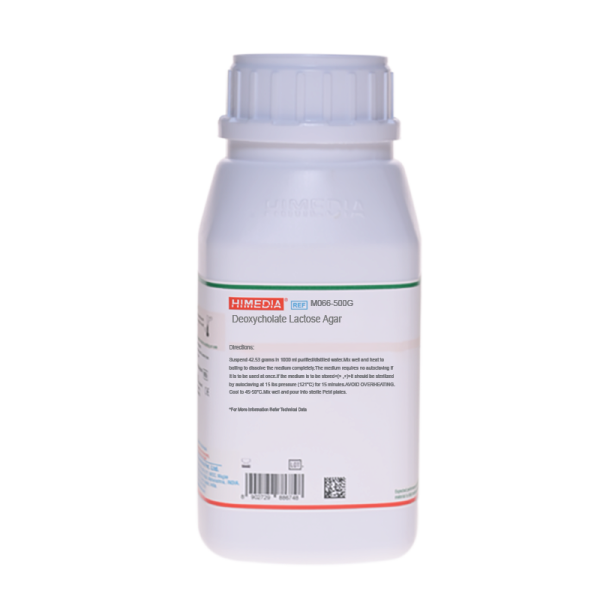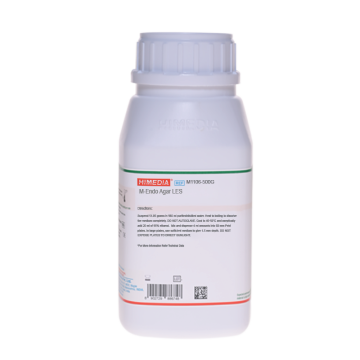 Your enquiry has been submitted
Your enquiry has been submitted
Deoxycholate Lactose Agar
Enterobacteriaceae#CC293D
Intended Use:
Recommended for isolation and enumeration of coliforms in water, waste-water, milk and dairy products.
Composition**
| Ingredients | g / L |
|---|---|
| Peptone, special | 10.000 |
| Lactose | 10.000 |
| Sodium chloride | 5.000 |
| Sodium citrate | 2.000 |
| Sodium deoxycholate | 0.500 |
| Neutral red | 0.030 |
| Agar | 15.000 |
Final pH (at 25°C): 7.1±0.2
**Formula adjusted, standardized to suit performance parameters
Directions
Suspend 42.53 grams in 1000 ml purified/distilled water. Mix well and heat to boiling to dissolve the medium completely. The medium requires no autoclaving if it is to be used at once. If the medium is to be stored, it should be sterilized by autoclaving at 15 lbs pressure (121°C) for 15 minutes. AVOID OVERHEATING. Cool to 45-50°C. Mix well and pour into sterile Petri plates.
Principle And Interpretation
Deoxycholate Lactose Agar is a modification of Deoxycholate Agar as described by Leifson (1) and prepared according to formula specified in Standard Methods for Examination of Dairy Products (2) Water and Waste Water (3) and Food (4) for the detection of coliform bacilli. It differs from Deoxycholate Agar (GM030) by its decreased concentration of sodium deoxycholate. Pour plate method is carried out using suitable dilutions. A thin layer of additional agar can be poured over the solidified pour plates to facilitate enumeration.
Deoxycholate Lactose Agar is selective against gram-positive organisms which are inhibited by optimum concentration of sodium deoxycholate and sodium citrate in the medium. It helps to differentiate between lactose fermenting and nonfermenting enteric bacilli. Peptone special provides nitrogeneous and carbonaceous compounds, long chain amino acids and other essential nutrients. Lactose helps in differentiating enteric bacilli, as lactose fermenters produce red colonies while lactose non- fermenters produce colourless colonies. Coliform bacteria, if present form pink colonies on this medium. The degradation of lactose causes acidification of the medium surrounding the relevant colonies and the pH indicator neutral red changes its colour to red. These colonies usually are also surrounded by a turbid zone of precipitated deoxycholic acid due to acidification of the medium. Sodium deoxycholate combines with neutral red in an acidic environment, causing the dye to go out of the solution with the subsequent precipitation of deoxycholate (1).
Type of specimen
Dairy samples; Water samples
Specimen Collection and Handling:
For dairy samples, follow appropriate techniques for sample collection and processing as per guidelines (5,6). For water samples, follow appropriate techniques for sample collection, processing as per guidelines and local standards.(3) After use, contaminated materials must be sterilized by autoclaving before discarding.
Warning and Precautions :
Read the label before opening the container. Wear protective gloves/protective clothing/eye protection/ face protection. Follow good microbiological lab practices while handling specimens and culture. Standard precautions as per established guidelines should be followed while handling specimens. Safety guidelines may be referred in individual safety data sheets.
Limitations :
- Certain Salmonella species are lactose non-fermentors and certain species are non H2S producers.
- This medium is a selective medium and needs to be run ion parallel with other media for confirmation.
- Other biochemical and serological tests must be carried out for confirmation.
Performance and Evaluation
Performance of the medium is expected when used as per the direction on the label within the expiry period when stored at recommended temperature.
Quality Control
Appearance Light yellow to pink coloured homogeneous free flowing powder.
Gelling Firm, comparable with 1.5% Agar gel
Colour and Clarity of prepared medium Reddish orange coloured, clear to slightly opalescent gel forms in Petri plates
Reaction Reaction of 4.25% w/v aqueous solution at 25°C. pH: 7.1±0.2
pH 6.90-7.30
Cultural Response Cultural characteristics observed after an incubation at 35-37°C for 18-24 hours.
| Organism | Inoculum (CFU) | Growth | Recovery | Colour of colony |
|---|---|---|---|---|
| ** Bacillus spizizenii ATCC 6633 (00003*) | >=104 | inhibited | 0% | |
| Escherichia coli ATCC 25922 (00013*) | 50-100 | good-luxuriant | >=50% | pink w/bile precipitate |
| # Klebsiella aerogenes ATCC 13048 (00175*) | 50-100 | good - luxuriant | >=50% | pink |
| Enterococcus faecalis ATCC 29212 (00087*) | >=104 | inhibited | 0% | |
| Salmonella Typhimurium ATCC 14028 (00031*) | 50-100 | good-luxuriant | >=50% | colourless |
Key: (*) Corresponding WDCM numbers. (#) Formerly known as Enterobacter aerogenes **Formerly known as Bacillus subtilis subsp. spizizenii
Storage and Shelf Life
Store between 10-30°C in a tightly closed container and the prepared medium at 20-30°C. Use before expiry date on the label. On opening, product should be properly stored dry, after tightly capping the bottle in order to prevent lump formation due to the hygroscopic nature of the product. Improper storage of the product may lead to lump formation. Store in dry ventilated area protected from extremes of temperature and sources of ignition. Seal the container tightly after use. Product performance is best if used within stated expiry period.
Disposal
User must ensure safe disposal by autoclaving and/or incineration of used or unusable preparations of this product. Follow established laboratory procedures in disposing of infectious materials and material that comes into contact with sample must be decontaminated and disposed of in accordance with current laboratory techniques (7,8).
Reference
- Leifson, 1935, J. Path. Bact., 40:581.
- Richardson (Ed.), 1985, Standard Methods for the Examination of Dairy Products, 15th ed., APHA, Washington, D.C.
- Lipps WC, Braun-Howland EB, Baxter TE, eds. Standard methods for the Examination of Water and Wastewater, 24th ed. Washington DC:APHA Press; 2023.
- Salfinger Y., and Tortorello M.L., 2015, Compendium of Methods for the Microbiological Examination of Foods, 5th Ed., American Public Health Association, Washington, D.C.
- American Public Health Association, Standard Methods for the Examination of Dairy Products, 1978, 14th Ed., Washington D.C.
- Wehr H. M. and Frank J. H., 2004, Standard Methods for the Microbiological Examination of Dairy Products, 17th Ed., APHA Inc., Washington, D.C.
- Isenberg, H.D. Clinical Microbiology Procedures Handbook 2nd Edition.
- Jorgensen, J.H., Pfaller, M.A., Carroll, K.C., Funke, G., Landry, M.L., Richter, S.S and Warnock., D.W. (2015) Manual of Clinical Microbiology, 11th Edition. Vol. 1
| Product Name | Deoxycholate Lactose Agar |
|---|---|
| SKU | M066 |
| Product Type | Regular |
| Physical Form | Powder |
| Origin | Animal |
| Packaging type | HDPE |
| References | 1.Leifson, 1935, J. Path. Bact., 40:581. 2.Richardson (Ed.), 1985, Standard Methods for the Examination of Dairy Products, 15th ed., APHA, Washington, D.C. 3.Greenberg A. E., Eaton A. D., Clesceri L. S., (Eds.), 1998, Standard Methods for the Examination of Water and Waste Water,20th Ed., APHA, Washington, D.C. 4.Speck M. (Ed.), 1984, Compendium of Methods for the Microbiological Examination of Foods, 2nd ed., APHA, Washington,D.C. |
| Customized Product Available | No |








